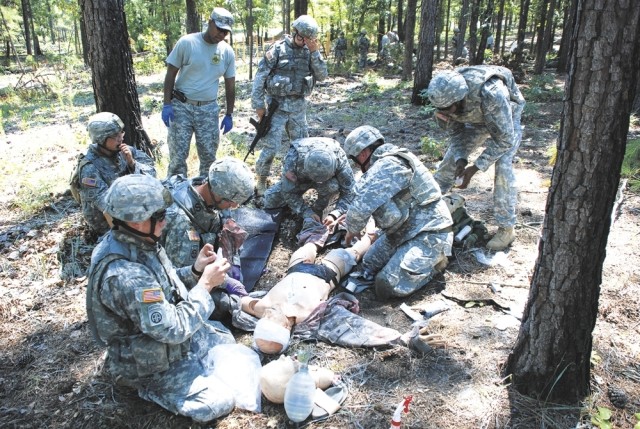
FORT SAM HOUSTON, Texas Aca,!" The newly formed Army Medical Department Center and SchoolAca,!a,,cs Center for Predeployment Medicine at Fort Sam Houston prepares medical specialists for deployment with training that covers everything from battlefield first aid to working in combat support hospitals.
The CPDM conducts four courses that were previously offered through various departments at the AMEDD Center and School Aca,!" some of which had curriculum redundancy among them.
Having the courses managed by a single center allows for greater support and frequency of courses, and training which used to be optional will become mandatory, CPDM officials said.
Aca,!A"We want the units and people deploying to utilize our training so that we can decrease morbidity and mortality on the battlefield,Aca,!A? said Director Lt. Col. (Dr.) John McManus.
The courses are offered to combat medics, physicianAca,!a,,cs assistants, senior medical noncommissioned officers, physicians and nurses. The training prepares Soldiers for what they will experience in the field, said Armand Fermin, course coordinator for the Brigade Combat Team Trauma Training and Military Transition Team Medical Course at the CPDM.
Aca,!A"The first time a combat medic sees a casualty on the battlefield, they need to be confident and competent in their ability to do their job,Aca,!A? said Fermin, a retired first sergeant. Aca,!A"We provide that confidence and competence.Aca,!A?
The following courses are offered by the CPDM, which is part of the Academy of Health Sciences.
Brigade Combat Team Trauma Training
The five-day BCT3 is for combat medics assigned to brigade combat teams. The training focuses on tactical combat casualty care, which includes controlling bleeding, treating chest wounds and their associated problems, and clearing airway obstructions, said retired Army PA Casey Bond, a program manager at the center. Much of the training is performed in the field in battlefield and urban environments, according to BCT3 literature.
Military Transition Team Medical Course
The MiTT training is for the teamAca,!a,,cs medical NCO. MiTTs are teams of 12 to 20 Soldiers who are imbedded with Iraqi or Afghan security forces as trainers and advisers. The eight-day training covers tactical combat casualty care as well as working as an independent medical provider. The medical NCOs provide care for their teams and train their foreign counterparts as combat lifesavers, Fermin said.
Tactical Combat Medical Care Course
The TCMC course is geared toward PAs, doctors, nurse practitioners and senior medical NCOs who will be assigned to battalion aid stations and medical companies. The five-day course is a mix of didactic and hands-on realistic scenarios to prepare providers to go downrange, said Maj. Shon Compton, deputy director for the center. The course can be taught at the providersAca,!a,,c home units or at Fort Sam Houston, he said.
Joint Forces Combat Trauma Management Course
The five-day JFCTM Course is designed for physicians, nurses, senior medics and PAs who will be stationed at combat support hospitals. Course topics include advanced principals of critical care, stabilizing and transporting patients, and surgery, McManus said. Aca,!A"Basically, itAca,!a,,cs a couple days of epidemiology for learning whatAca,!a,,cs going on for morbidity and mortality and a couple days of break-out sessions,Aca,!A? he said
Fermin said some of the comments he has received from Soldiers who have taken the BCT3 course included: Aca,!A"I wish I had this training before on previous deployments Aca,!" I would have saved livesAca,!A? and Aca,!A"This is the best training that I have received in the Army.Aca,!A?
Similar comments have been made about the JFCTM Course, McManus said.
Aca,!A"Our next endeavor is to study the training and education that we are doing,Aca,!A? McManus said. Aca,!A"What we really want to do is start gathering true data on how we train and see how effective it was.Aca,!A?
For more information about the CPDM, visit http://www.cs.amedd.army.mil/Deployment/default.aspx.
(Jeff Crawley works for the Fort Sam Houston Public Affairs Office)

Social Sharing